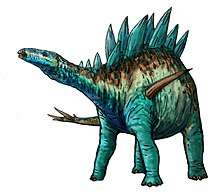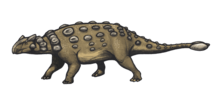Nodosaurinae
Nodosaurinae is a group of ankylosaurian dinosaurs named in 1919 by Othenio Abel.
| Nodosaurinae | |
|---|---|
 | |
| Old interpretation of Nodosaurus, the type genus | |
| Scientific classification | |
| Kingdom: | Animalia |
| Phylum: | Chordata |
| Clade: | Dinosauria |
| Order: | †Ornithischia |
| Suborder: | †Ankylosauria |
| Family: | †Nodosauridae |
| Subfamily: | †Nodosaurinae Abel, 1919 |
| Genera[1] | |
| Synonyms | |
|
Panoplosaurinae Nopsca, 1929 | |
History of classification
The subfamily Nodosaurinae was originally named by Othenio Abel in 1919. It originally included Ankylosaurus, from the Upper Cretaceous of North America, possibly Hierosaurus, and Stegopelta, from North America also. It was found to be very specialized and peculiar by Abel. Abel mentioned that the neck shield found in ceratopsians was very different from all nodosaurines, and that only the neck spines are present in Nodosaurinae. The body of nodosaurines is completely covered in strong armour plates, with a similar shape to tiles, and are lined up along the body. A large degree of pubic reduction was found in nodosaurines, a feature that is also found in Stegosaurus and Triceratops. Nodosaurines were all quadrupedal, and lived that way for their whole life. Quadrupedalism was found to be a feature in Stegosauridae, and Ceratopsidae.[2] It was unused for a long time, but in 2013 during the description of a new basal nodosaurid, Europelta, and the redefinition of Struthiosaurinae, James Kirkland and his colleagues found all North American nodosaurids to represent the derived group Nodosaurinae, while all European nodosaurids made up the basal clade Struthiosaurinae.[1]
Biogeography
The near simultaneous appearance of nodosaurids in both North America and Europe is worthy of consideration, because at the time, they were separated from each other by a huge body of water. Europelta is the oldest nodosaurid from Europe; it is derived from the lower Albian Escucha Formation. The oldest western North American nodosaurid is Sauropelta, from the lower Albian Little Sheep Mudstone Member of the Cloverly Formation, at an age of 108.5±0.2 million years. Eastern North American fossils seem older. Teeth of Priconodon crassus have been derived from the Arundel Clay of the Potomac Group of Maryland, which dates near the Aptian–Albian boundary. A Propanoplosaurus hatchling was uncovered from the base of the underlying Patuxent Formation, dated to the upper Aptian, making Propanoplosaurus the oldest nodosaurid.[1]
Polacanthids are known from pre-Aptian fauna from both Europe and North America. The timing of the appearance of nodosaurids on both continents indicates the origins of the clade preceded the isolation of North America and Europe, thereby pushing the group's date of evolution back to at least the middle Aptian. The separation of Nodosauridae into European Struthiosaurinae and North American Nodosaurinae by the end of the Aptian provides a revised date for the isolation of the continents from each other with rising sealevel.[1]
See also
References
- Kirkland, J.I.; Alcalá, L.; Loewen, M.A.; Espílez, E.; Mampel, L.; Wiersma, J.P. (2013). Butler, Richard J. (ed.). "The Basal Nodosaurid Ankylosaur Europelta carbonensis n. gen., n. sp. from the Lower Cretaceous (Lower Albian) Escucha Formation of Northeastern Spain". PLOS ONE. 8 (12): e80405. doi:10.1371/journal.pone.0080405. PMC 3847141. PMID 24312471.
- Abel, O.L.F.A.L. (1919). "Die Stämme der Wirbeltiere" (in German). Berlin und Leipzig: Walter de Gruyter. doi:10.5962/bhl.title.2114. Cite journal requires
|journal=(help)

